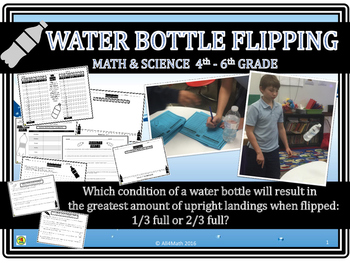Water Bottle Flipping Math and Science: 4th - 6th Grade
All4Math
244 Followers
Grade Levels
4th - 6th, Homeschool
Subjects
Resource Type
Standards
CCSS4.MD.A.2
CCSS5.MD.A.1
CCSS4.NBT.B.5
CCSS5.NBT.B.5
CCSS4.OA.A.2
Formats Included
- PDF
Pages
21 pages
All4Math
244 Followers
Description
My 5th & 6th graders FLIP for this math & science lesson! Students gather data using the scientific method to discover if a 1/3 full or 2/3 full water bottle will result in more upright landings. After writing their hypothesis, students flip water bottles 1/3 full and 2/3 full 20 times for each condition. They create class line plots of their data and find the median, mode, and mean of upright landings for both conditions. After analyzing their results, they write their conclusions. An extension activity of 2 levels of water bottle-themed word problems is also included.
Included:
~ 8 student pages of Water Bottle Flipping Experiment
~ 3 student pages of Water Bottle Flipping Word Problems and Data
~ sample class line plots
~ answer keys and sample conclusions
~ extensive teacher notes
~ pictures of experiment and data analysis
Thanks for stopping by All4Math!
You may also like:
Link-Pumpkin Math, Science, and Data Analysis - 3rd, 4th, 5th, 6th Grade
Link-M&M Math: Fractions, Decimals, Percents, Graphs, & Data Analysis
Water Bottle Flipping Math and Science: 4th - 6th Grade by All4Math is licensed under a Creative Commons Attribution-NonCommercial-NoDerivatives 4.0 International License.
Included:
~ 8 student pages of Water Bottle Flipping Experiment
~ 3 student pages of Water Bottle Flipping Word Problems and Data
~ sample class line plots
~ answer keys and sample conclusions
~ extensive teacher notes
~ pictures of experiment and data analysis
Thanks for stopping by All4Math!
You may also like:
Link-Pumpkin Math, Science, and Data Analysis - 3rd, 4th, 5th, 6th Grade
Link-M&M Math: Fractions, Decimals, Percents, Graphs, & Data Analysis
Water Bottle Flipping Math and Science: 4th - 6th Grade by All4Math is licensed under a Creative Commons Attribution-NonCommercial-NoDerivatives 4.0 International License.
Total Pages
21 pages
Answer Key
Included
Teaching Duration
90 minutes
Report this resource to TPT
Reported resources will be reviewed by our team. Report this resource to let us know if this resource violates TPT’s content guidelines.
Standards
to see state-specific standards (only available in the US).
CCSS4.MD.A.2
Use the four operations to solve word problems involving distances, intervals of time, liquid volumes, masses of objects, and money, including problems involving simple fractions or decimals, and problems that require expressing measurements given in a larger unit in terms of a smaller unit. Represent measurement quantities using diagrams such as number line diagrams that feature a measurement scale.
CCSS5.MD.A.1
Convert among different-sized standard measurement units within a given measurement system (e.g., convert 5 cm to 0.05 m), and use these conversions in solving multi-step, real world problems.
CCSS4.NBT.B.5
Multiply a whole number of up to four digits by a one-digit whole number, and multiply two two-digit numbers, using strategies based on place value and the properties of operations. Illustrate and explain the calculation by using equations, rectangular arrays, and/or area models.
CCSS5.NBT.B.5
Fluently multiply multi-digit whole numbers using the standard algorithm.
CCSS4.OA.A.2
Multiply or divide to solve word problems involving multiplicative comparison, e.g., by using drawings and equations with a symbol for the unknown number to represent the problem, distinguishing multiplicative comparison from additive comparison.





